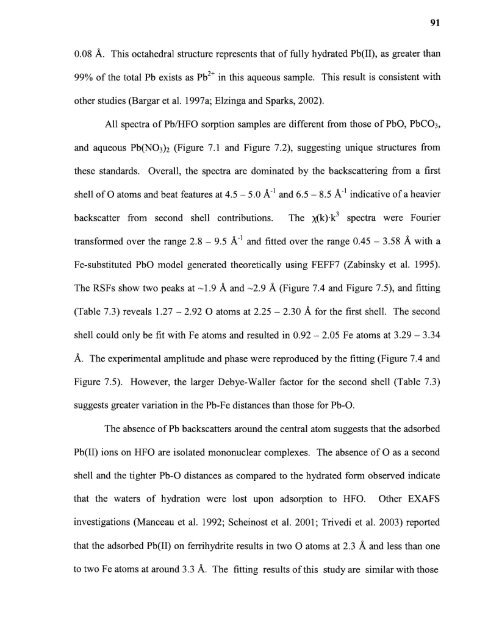Heavy metal adsorption on iron oxide and iron oxide-coated silica ...
Heavy metal adsorption on iron oxide and iron oxide-coated silica ...
Heavy metal adsorption on iron oxide and iron oxide-coated silica ...
You also want an ePaper? Increase the reach of your titles
YUMPU automatically turns print PDFs into web optimized ePapers that Google loves.
910.08 A. This octahedral structure represents that of fully hydrated Pb(II), as greater than99% of the total Pb exists as Pb 2+ in this aqueous sample. This result is c<strong>on</strong>sistent withother studies (Bargar et al. 1997a; Elzinga <strong>and</strong> Sparks, 2002).All spectra of Pb/HFO sorpti<strong>on</strong> samples are different from those of PbO, PbCO3,<strong>and</strong> aqueous Pb(NO3)2 (Figure 7.1 <strong>and</strong> Figure 7.2), suggesting unique structures fromthese st<strong>and</strong>ards. Overall, the spectra are dominated by the backscattering from a firstshell of O atoms <strong>and</strong> beat features at 4.5 — 5.0 A 1 <strong>and</strong> 6.5 — 8.5 A-1 indicative of a heavierbackscatter from sec<strong>on</strong>d shell c<strong>on</strong>tributi<strong>on</strong>s. The x(k)•k 3 spectra were Fouriertransformed over the range 2.8 — 9.5 A -1 <strong>and</strong> fitted over the range 0.45 — 3.58 A with aFe-substituted PbO model generated theoretically using FEFF7 (Zabinsky et al. 1995).The RSFs show two peaks at —1.9 A <strong>and</strong> —2.9 A (Figure 7.4 <strong>and</strong> Figure 7.5), <strong>and</strong> fitting(Table 7.3) reveals 1.27 — 2.92 O atoms at 2.25 — 2.30 A for the first shell. The sec<strong>on</strong>dshell could <strong>on</strong>ly be fit with Fe atoms <strong>and</strong> resulted in 0.92 — 2.05 Fe atoms at 3.29 — 3.34A. The experimental amplitude <strong>and</strong> phase were reproduced by the fitting (Figure 7.4 <strong>and</strong>Figure 7.5). However, the larger Debye-Waller factor for the sec<strong>on</strong>d shell (Table 7.3)suggests greater variati<strong>on</strong> in the Pb-Fe distances than those for Pb-O.The absence of Pb backscatters around the central atom suggests that the adsorbedPb(II) i<strong>on</strong>s <strong>on</strong> HFO are isolated m<strong>on</strong><strong>on</strong>uclear complexes. The absence of O as a sec<strong>on</strong>dshell <strong>and</strong> the tighter Pb-O distances as compared to the hydrated form observed indicatethat the waters of hydrati<strong>on</strong> were lost up<strong>on</strong> <str<strong>on</strong>g>adsorpti<strong>on</strong></str<strong>on</strong>g> to HFO. Other EXAFSinvestigati<strong>on</strong>s (Manceau et al. 1992; Scheinost et al. 2001; Trivedi et al. 2003) reportedthat the adsorbed Pb(II) <strong>on</strong> ferrihydrite results in two O atoms at 2.3 A <strong>and</strong> less than <strong>on</strong>eto two Fe atoms at around 3.3 A. The fitting results of this study are similar with those
















